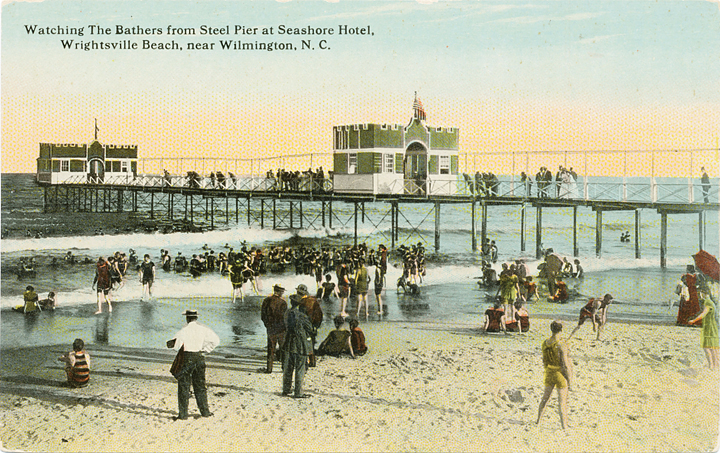Hand-made wooden crafts chased each other through the warm waters of Banks Channel, their captains navigating between the low-lying island known as the Hammocks and the rugged outer beach strand. The small boats raced back and forth in front of the solitary building clinging to the barren strip of land, a wooden structure with a wrap-around porch.
During the mid 19th century, that building, the Carolina Yacht Club, offered the first glimpse of development on the island that would soon become the town of Wrightsville Beach.
At that time the island was called Ocean View Beach. Wrightsville was the name given to the nearby village located on the mainland overlooking the sound. The only passage from Wrightsville village to Ocean View Beach was by boat.
The first to spend time at the beach were adventurous campers, fishermen and explorers, as the island had no electricity, bathhouses or running water. In a 1938 issue of the Wilmington Star, Wrightsville Beach Mayor J. A. Taylor recalled those early years.
“A small spring near the present location of the Lumina Pavilion was the only source of fresh water and that was covered when the tide rose,” he wrote. “At low tide those camping on the beach would travel to the water hole with all the small vessels they had which were empty and these they filled with fresh water to last them until the tide had again subsided.”
Around 1875, a toll road made of shells and dirt was constructed from downtown Wilmington to Wrightsville Sound so residents could make the 1-hour trip directly from the city to the seaside. Today, the shell road is paved and known as Wrightsville Avenue.
The Wilmington Star advertised a round-trip ticket on a horse-drawn cart called the Wagonette for the price of $1. Wrightsville Sound became a destination for families to come spend a few days of the summer months bathing and relaxing.
In 1887 Wilmington & Seacoast Railroad began construction of a railroad following a similar path to the shell road. A 1-mile trestle over the marsh allowed the railroad to extend all the way to the Hammocks, which is now called Harbor Island. From there, residents walked a footbridge to Ocean View Beach. A hotel and a bowling alley were soon constructed on the Hammocks in response to the inundation of tourists.
Shortly after, another railroad company extended the train tracks over Banks Channel and down to the south end of the beach. The open-air passenger cars allowed visitors to feel the sea breeze as they cruised down the beach strand.
The new rail lines brought an influx of people and created a need for accommodations. The first structures to appear were bathhouses where beachgoers could shower and rent lockers or bathing suits.
Lodging was necessary because there were so few permanent residents on the island. The Ocean View Hotel, the Atlas House, the Breeze House and the Seashore Hotel were some of the first hotels to appear. By 1895, 34 cottages also occupied the narrow beach strand, the Wilmington Messenger reported.
In 1899, the beach was incorporated and thus Ocean View Beach became Wrightsville Beach.
Samuel Northrop took the oath of office as mayor and on May 29, 1899, the board of aldermen met for the first time to discuss improvements to the Carolina Yacht Club.
Development of the resort town continued to accelerate, hindered only temporarily by a devastating hurricane later that year. Illustrated postcards from the early 20th
century depict masses of swimsuit-clad bathers enjoying the ocean or elegantly dressed men and women strolling down the boardwalk or the steel pier of the Seashore Hotel.
Around that time, Hugh MacRae’s business, Consolidated Railways, Light & Power Company (later called Tidewater Power Company) purchased the Wilmington & Seacoast Railroad and converted the steam line into an electric trolley. In 1914, the Tidewater Power Company also bought a large portion of Wrightsville Beach for $3,500, or $1.50 per acre.
MacRae indicated plans for a massive building project involving dredging the waterway, constructing a large hotel and building more miles of trolley line. His long-term intention, the Wilmington Dispatch reported, was to transform Wrightsville Beach into a tourist destination: a resort town that would thrive during both the summer months and the winter months.
email [email protected]




